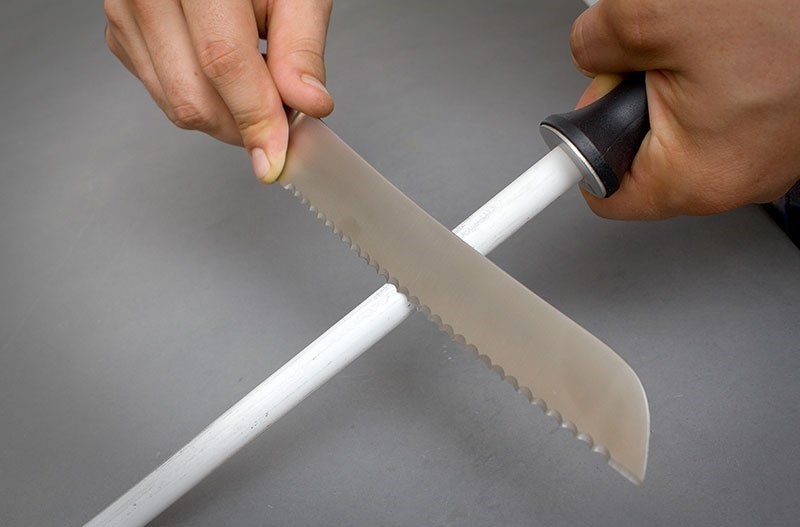
A serrated knife tends to be longer than a regular flat knife, and the sharpness is more difficult to restore without changing its shape. For this reason, it is best if a serrated knife is sharpened only when its effectiveness is visibly diminished. However, how to sharpen the knife, if you have more money, buy a serrated knife sharpener to solve the problem easily.
We are all aware that a serrated knife is often the best choice when cutting bread, tomatoes, and a variety of other foods. But how can that be?
The serration points concentrate the downward force onto the smaller portions of the food. That way they will more easily penetrate the outer surface (which is often tougher than the inner). Then you can look back and forth to expand the pinpricks.
So the dots do a bit more work than the ‘valley’ (known in official terms as the ‘esophagus’) between them. Therefore, they require more wear and tear.
then how to sharpen the bread knife :
- Purchase a serrated knife sharpener. Serrated knives require a different sharpener than regular flat knives. Most serrated knife sharpeners are rod-shaped and are usually tapered to sharpen various sizes of serrations.
- Find the side of the knife with the beveled edge. Serrated blades are usually not the same from both sides. On the one hand, the angle on the face of the blade will remain the same until the blade eye. On the other hand, the blade face will be slightly angled down from the serrated edge; This model is called bevel. Sharpeners should only be used on beveled edges.
- Place the sharpening rod in one of the curves (“fan”) of the serrations. Selecting an angle on the serrated blade is easier because you can use the bevel angle as a guide.
- This angle is usually between 13-17 degrees from the blade, which is shallower than what is typically used for sharpening ordinary knives.
- If the blade also has a flat edge, the angle is usually at the same angle, about 20-25 degrees.
- If you want a better guide, scratch the edges of the curve using a permanent marker. You are sure to sharpen at the right angle if these marker marks are missing.
- Move the sharpening rod according to the diameter of the curve. If the sharpening rod is tapered, find a point on the rod that is the same diameter as or slightly smaller than the serration curve of the knife.
- Sharpen the curve of the first serration. Wipe the mounting rod along the first curve in a few short swipes. Press in one direction from the blade towards the back. Rotate the rod as you push it to increase friction.
- Continue to sharpen each recess in the knife. If the serrations vary in size, adjust the position of the sharpening rod so that it only fills the recess.
- Sand all the thorns. The thorns here are the metal shavings that appear when sharpening the blade. To get rid of it, rub the back of the knife with a fine grit sandpaper. Otherwise, you can rub the sharpening rod lightly against the back of each recess, being careful not to apply more pressure than necessary.
- Sharpen the flat part of the blade. If the knife is only serrated in one part of the blade, sharpen the rest with a sharpening stone or other tool. Do not use a serrated knife sharpener on a flat eye.
Tips
- Taking good care of the knife will reduce the frequency of sharpening. Knives should not be washed in the dishwasher or on a glass cutting board.
- Diamonds and carbides are the most aggressive sharpeners; it works fast, but a lot of metal is scraped off. Ceramic sharpeners and Arkansas stones (novaculite) are gentler on the blade, and are great for finishing the sharp edges.[9]
Clamp the knife in a vise to make the job safer and easier. This is even more important if you use an emery cloth as your fingers will be positioned close to the sharp edges.
